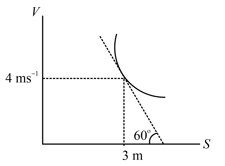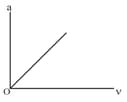Variable Acceleration
Variable Acceleration: Overview
This topic covers concepts, such as, Velocity Dependent Acceleration, Velocity Function in Velocity Dependent Acceleration, Motion with Position Dependent Acceleration & Motion with Velocity Dependent Acceleration etc.
Important Questions on Variable Acceleration
The displacement of a particle varies with time as , where , , are positive constants. The velocity of the particle will
The displacement of a particle is represented by the following equation : where s is in metres and t is seconds. The acceleration of the particle at is
A Particle located at x = 0 at time t = 0, starts moving along the positive x-direction with a velocity that varies as . The displacement of the particle varies with time as –
The coordinate of a particle moving on x-axis is given by where is in and is time in seconds. Find the maximum distance the particle can move from the origin (in
A particle starts from point with zero initial velocity, moves along a straight line path with an acceleration given by where are constants and is distance from point The particle stops at point Find the maximum velocity of the particle when and
A particle moves in a straight line with a retardation proportional to its displacement. Its loss of kinetic energy for any displacement is proportional to,
A cart is moving horizontally along a straight line with constant speed . A projectile is to be fired from the moving cart in such a way that it will return to the cart after the cart has moved . At what speed (relative to the cart) must the projectile be fired (take )?
A particle is moving along a straight line whose velocity-displacement graph is as shown in the figure. What is the magnitude of acceleration when displacement is ?

Under the influence of a force of attraction towards the origin , a particle of mass moves. The force is given by expression . If the particle starts from rest at , find the speed it will attain to reach when it is at a distance from the origin.
The magnitude of displacement vector of a particle moving in a circle of radius with constant angular velocity ω as a function of time is
A particle starts from point A and moves along a straight line path with an acceleration given by a = p – qx where p, q are constants and x is distance from point A. The particle stops at point B. The maximum velocity of the particle is
The velocity of a particle at any instant is . The equation of trajectory of the particle is:
If the velocity of a particle is , where and are constants, then the distance travelled by it between and is:
The position (x) of a particle varies with time as , then acceleration of particle is
A point moves with uniform acceleration and its initial speed and final speed are and respectively then, the space average of velocity over the distance moved is. (in ) :-
The distance from the origin of a particle moving in plane varies with time as and the angle made by the radius vector with positive -axis is . Here, is in second, in metre and in radian. The speed of the particle at is
Acceleration velocity graph of a particle moving in a straight line is as shown in figure. The slope of velocity-displacement graph
A bee files a line from a point to another point in with a velocity of . The distance between and in metre is
Acceleration of a body for displacement equation, is
The acceleration of a particle moving in straight line is defined by the relation , where is acceleration in and is the position in meter. If velocity when x = 0, then the velocity of the particle when x = 4 meter is:

